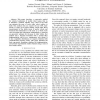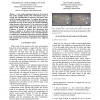ICRA
2003
IEEE
14 years 5 months ago
2003
IEEE
—Mobile robot teams are increasingly deployed in various applications involving remote operations in unstructured environments that do not support wireless network infrastructure...
ICRA
2003
IEEE
14 years 5 months ago
2003
IEEE
To safely and efficiently guide search and rescue operations in disaster areas, gathering of relevant information such as the locations of victims, must occur swiftly. Using the c...
ICRA
2003
IEEE
14 years 5 months ago
2003
IEEE
— Robots typically have many sensors which are underutilized. This is usually because no simple mathematical models of the sensors have been developed or the sensors are too nois...
ICRA
2003
IEEE
14 years 5 months ago
2003
IEEE
- The subject of this paper is a hybrid hip biped climbing robot. The hybrid hip provides both prismatic and revolute motion, discretely, to the robot, using a single actuator. Thi...
ICRA
2003
IEEE
14 years 5 months ago
2003
IEEE
This paper presents a humanoid robot that has the same size as a human and that can lie down to the floor and get up from the floor with the robot face upward and downward. We b...
ICRA
2003
IEEE
14 years 5 months ago
2003
IEEE
— This paper describes a cooperative method for relative localization of mobile robot teams; that is, it describes a method whereby every robot in the team can estimate the pose ...
ICRA
2003
IEEE
14 years 5 months ago
2003
IEEE
- A new motion planning framework is presented that enables multiple mobile robots with limited ranges of sensing and communication to maneuver and achieve goals safely in dynamic ...
ICRA
2003
IEEE
14 years 5 months ago
2003
IEEE
Adversarial multi-robot problems, where teams of robots compete with one another, require the development of approaches that span all levels of control and integrate algorithms ra...
ICRA
2003
IEEE
14 years 5 months ago
2003
IEEE
— As people move through their environments, they do not move randomly. Instead, they are often engaged in typical motion patterns, related to specific locations they might be i...
ACSC
2003
IEEE
14 years 5 months ago
2003
IEEE
In response to Searle's well-known Chinese room argument against Strong AI (and more generally, computationalism), Harnad proposed that if the symbols manipulated by a robot ...




